
The war and withdrawal from Afghanistan, a timeline
Here are some important events in the timeline of the U.S. war and withdrawal from Afghanistan, as reported at the time and cataloged by the Council on Foreign Relations.
September 11, 2001 – The United States is attacked by al-Qaeda backed terrorists, leading to the loss of almost 3,000 American lives.
October 7, 2001 – U.S. and British forces begin bombing Taliban positions and forces in Afghanistan. The first wave of ground troops arrive 12 days later.
November, 2001 – Kabul falls to U.S. led coalition forces, the next month the Taliban surrenders at Kandahar.
April 17, 2002 – President Bush calls for the “reconstruction” of Afghanistan. The following month, Secretary of Defense Donald Rumsfeld declares “major combat” in Afghanistan has ended.
October 9, 2004 – Afghan President Hamid Karzai is elected in the country’s first democratic elections.
May, 2005 – Bush and Karzai agree to a joint commitment allowing U.S. forces to prosecute the war on terror from Afghan bases.
February 17, 2009 – After President Barack Obama takes office, he announces a “surge” in occupation forces; by the end of the year, U.S. troop strength over 100,000. Obama says troops will begin to leave by July, 2011.
May 1, 2011 – al-Qaeda leader and 9/11 mastermind Osama bin Laden is killed in Pakistan by U.S. forces. The following month, Obama says 33,000 of the troops will leave Afghanistan, leaving 77,000 in place.
October, 2011 – Ten years at war.
June, 2013 – The Afghan military takes over security operations in the country.
May, 2014 – Obama announces further troop drawdown, plans to leave 9,800 troops in place for combat operations.
January, 2017 – President Donald Trump takes office, months later announces he will delegate decision making in Afghanistan to commanders on the ground and potentially deploy several thousand more troops. Trump says the war may drag on, even though his “original instinct was to pull out.”
January, 2018 – The Taliban steps up attacks. Trump bombs the opium labs funding the group.
September, 2019 – Trump calls off peace talks with Taliban after a U.S. service member is killed.
February, 2020 – Trump Administration signs agreement with Taliban promising troop withdrawal within 14 months. To foster peace talks, administration agrees to a prisoner swap that will see 5,000 Taliban fighters released.
September, 2020 – Intra-Afghanistan peace talks begin in Doha, Qatar. The following month, the U.S. announces it will lower troop levels to 2,500 by January.
April, 2021 – After President Joe Biden takes office, he announces he will not keep to the deadline set by the Trump administration to withdraw all troops by May, instead the remaining 3,500 troops will leave by September.
August 16, 2021 – Kabul falls to Taliban forces. Afghan President Ghani flees the country. Biden deploys 6,000 troops to help with evacuation of Afghan allies.
August 26, 2021 – Thirteen U.S. Service members are killed in a suicide bombing at Kabul airport along with more than 170 Afghan civilians.
August 31, 2021 – Nearly 20 years of war come to a close. 120,000 Afghans are evacuated, along with all U.S. military personnel.


